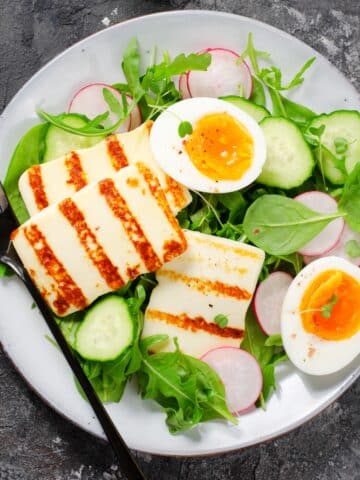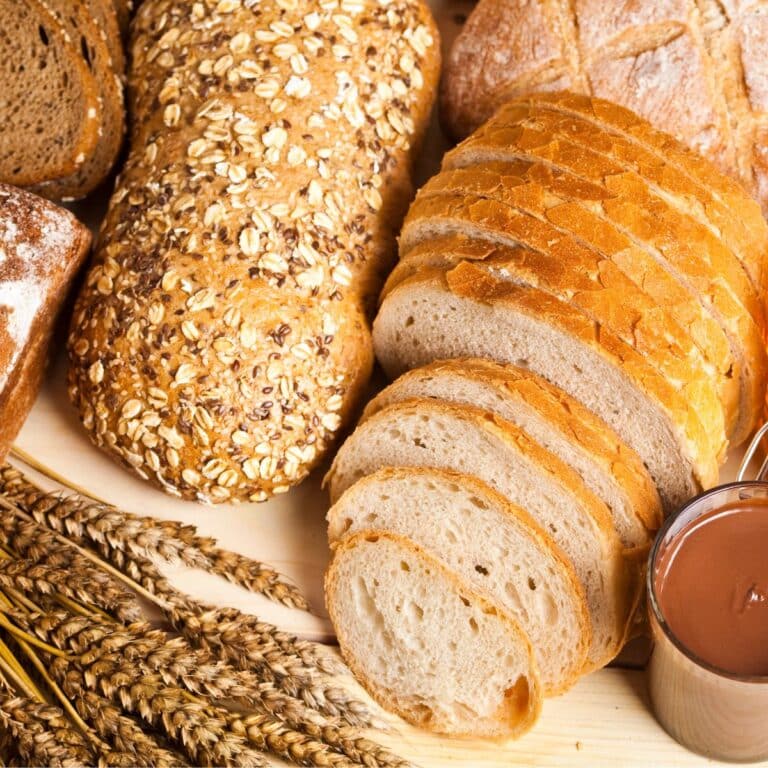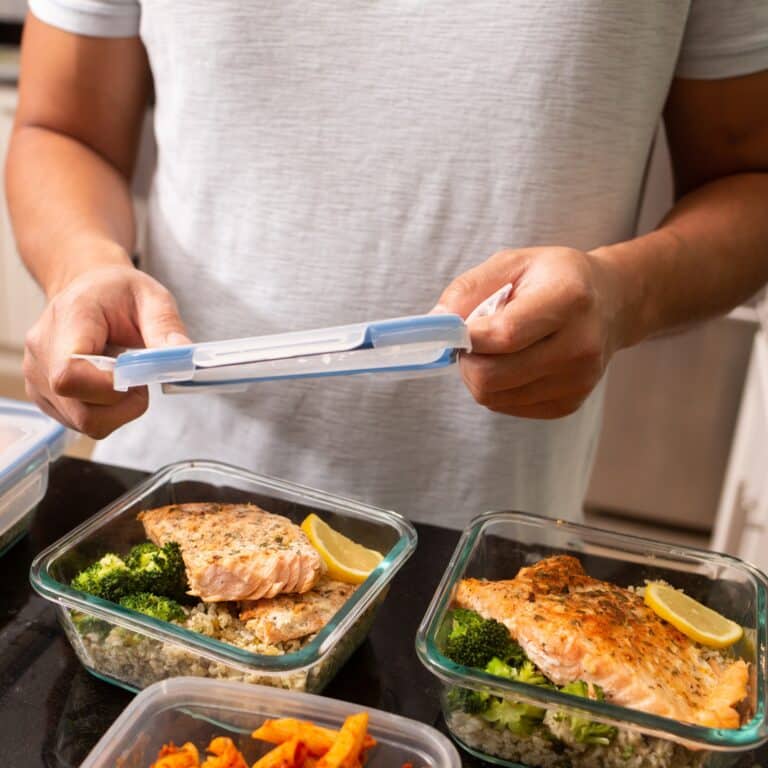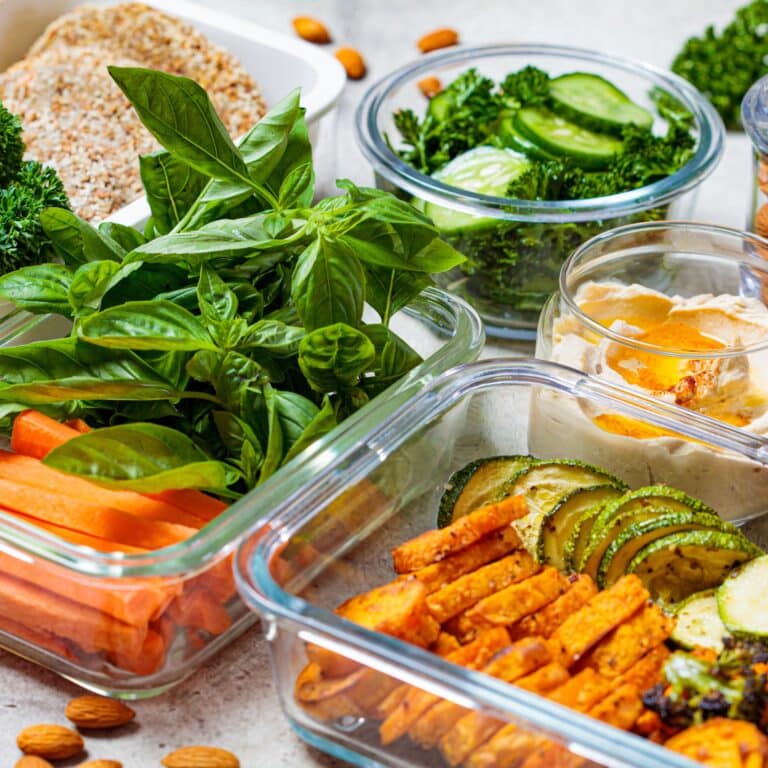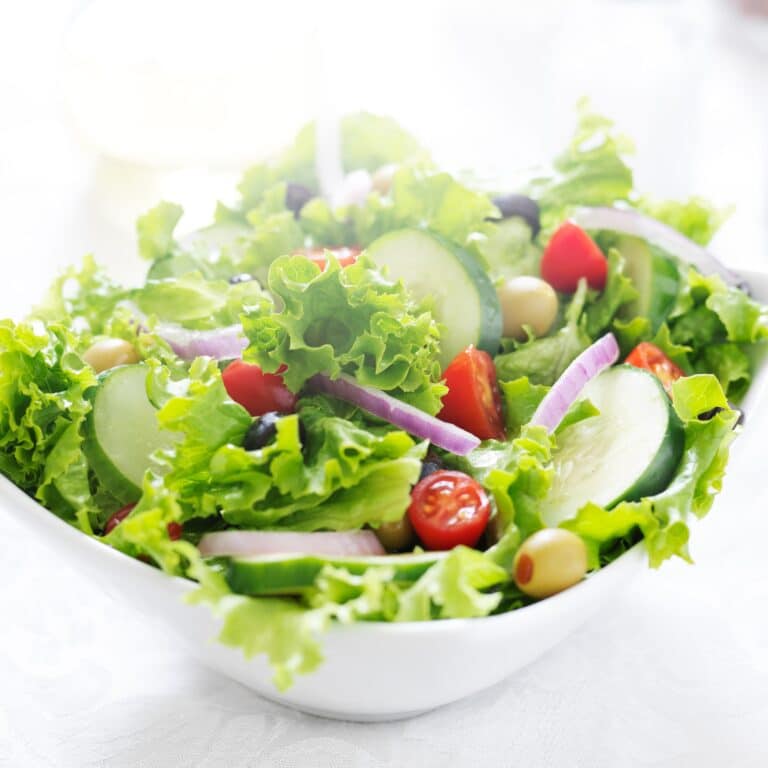Dialysis Diet Menu Plan
You're on dialysis, and your diet's pivotal in maintaining your health. That's where the Dialysis Diet Menu Plan comes in, your guide to managing protein, phosphorus, sodium, and potassium.
It's not just about avoiding certain foods, it's about finding kidney-friendly options that nourish and satisfy. From choosing the right grains to understanding dairy alternatives, this plan is tailored to your needs as you deal with Chronic Kidney Disease.

Let's get started on a path to better kidney health through mindful eating while following this food plan.
Jump to:
Key Takeaways
- Reduce salt intake and be mindful of hidden sources of sodium in processed foods.
- Include high protein foods in each meal, aiming for 8-10 ounces daily.
- Choose grains and cereals in moderation, and limit whole grain and high fiber options.
- Limit dairy intake and opt for low-phosphorus alternatives or non-dairy options.
For More Recipes and Ideas --->> Get Your Free Meals and Recipes That Are Perfect for Pre-Dialysis Diets, Pre-Dialysis with Diabetes, or Dialysis Diets.
Understanding Sodium Control
You'll need to be vigilant about your sodium intake, as it's crucial for controlling blood pressure and fluid balance in your body.
Start by swapping out salt for herbs and spices and always read labels to steer clear of hidden sodium in processed foods and salt substitutes that might be high in potassium.
Hidden Sodium Sources
Awareness of the amounts of sodium and the presence in many foods is essential as you navigate your dialysis kidney diet to maintain optimal health. Hidden sodium sources are everywhere and it's vital to implement salt reduction strategies as part of your routine.
Consider these aspects:
- Tracking sodium intake meticulously to avoid excess.
- Use food labels to monitor your daily consumption.
- Keep a food diary for accountability and awareness.
Exploring alternative seasoning options that enhance flavor without harm:
- Herbs and spices can replace salt in recipes.
- Lemon juice or vinegar add zest to dishes.
Employing recipe modification tips to lower sodium content:
- Cook from scratch to control ingredients.
- Rinse canned vegetables to reduce sodium.

Salt Substitution Strategies for Chronic Kidney Disease
Understanding effective salt substitution strategies is crucial when you're adapting your diet to manage kidney health on dialysis. Salt reduction benefits your blood pressure and overall wellness, but it doesn't mean your meals must lack flavor. Look into alternative seasoning options that can enhance your dishes without the added sodium.
Crafting homemade dialysis meals gives you control over what you eat. Use ingredient substitution tips and recipe adaptation strategies to create meals that are both kidney-friendly and delicious. Here's an informational table to guide you:
| Instead of Salt, Use... | Why It's Better |
|---|---|
| Herbs (e.g., basil, oregano) | Zero sodium & full of flavor |
| Spices (e.g., paprika, turmeric) | Adds zest without the salt |
| Citrus juice or zest | Brightens dishes naturally |
| Vinegar (e.g., balsamic) | Provides tanginess & complexity |
| Salt-free blends (e.g., Mrs. Dash) | Convenient & kidney-friendly |
Prioritizing Protein Intake
You need to ensure you're getting enough protein to maintain your health while on dialysis. Stick to proper portion sizes, about 8-10 ounces of high-quality protein daily is crucial for your body's needs and healthy kidneys.
Adequate Protein Sources
In managing your kidney health, it's crucial to prioritize high-quality protein sources in your dialysis diet menu to maintain muscle and overall strength.
Here's how you can focus on protein while considering phosphorus management and enjoying the benefits of homemade meals:
- Protein Portion Sizes
- 3 ounces of cooked meat: the size of a deck of cards
- Consider lean poultry, fish, and egg whites for high-quality protein
- Protein Sources and Phosphorus Management
- Choose dairy alternatives like almond or rice milk to reduce phosphorus
- Opt for fresh pork and avoid processed meats
- Homemade Meal Benefits
- Tailor meals to your nutritional needs
- Ensure proper portion control
- Experience the joy of cooking as a form of self-care
Portion Size Matters
Properly managing your protein portions ensures you get enough to maintain muscle mass without overloading your kidneys. When you're on dialysis, portion control isn't just a suggestion, it's crucial. Prioritize high-quality protein sources, such as lean meats, while being mindful of the recommended 3-ounce serving size, about the size of a deck of cards for people with kidney disease.
While whole grains offer essential nutrients, they should be limited due to phosphorus content. Opt for dairy alternatives like rice milk to further protect your kidney function.
Embrace homemade meals where you can measure and know exactly what you're consuming. When you do this you'll nourish your body effectively, ensuring your dietary choices align with your health needs and the service you wish to provide to your well-being.
Selecting Grains and Cereals
When choosing grains and cereals, you'll need to be mindful of phosphorus content, as it's essential to manage this mineral carefully in your diet.
It's recommended to stick to portion sizes that align with your health goals, which your dietitian can help you determine.
Phosphorus in Grains
You'll need to choose your grains and cereals carefully due to the high phosphorus content often found within these foods. Managing phosphorus in grains is crucial for your health and understanding phosphorus rich foods is essential.
Phosphorus control in your diet:
- Look for low phosphorus options
- Embrace grains that won't compromise your health
- Feel empowered by making informed choices
- Avoiding phosphorus rich foods:
- Recognize and limit high phosphorus grains
- Seek alternatives that bring you joy and wellness
- Nourish your body without overloading it with phosphorus
- Phosphorus management strategies:
- Consult with a dietitian for personalized guidance
- Keep your diet balanced and your kidneys happy
- Take control and live your best life with kidney-friendly foods, while establishing a meal plan.
Portion Size Guidance
In selecting grains and cereals for your dialysis kidney diet, it's vital to be attentive to portion sizes to manage your phosphorus levels effectively. Understanding sodium control is crucial, as many grains come with hidden sodium sources.
Use portion size guidance to avoid excess intake and consider salt substitution strategies when preparing your meals. Prioritizing protein intake doesn't mean compromising on grains, it's about balance and choosing wisely.
| Grain Type | Recommended Portion Size |
|---|---|
| White rice | ½ cup cooked |
| Whole wheat bread | 1 slice |
| Unsweetened cereal | 1 cup |
| Cooked pasta | ½ cup |
Dairy and Alternative Choices
When managing your dialysis diet, it's crucial to be aware that most dairy products are high in phosphorus, which can be harmful to your kidney health. However, you've got options like butter, cream cheese, and non-dairy alternatives such as rice milk that are lower in phosphorus.
Always discuss these choices with your dietitian to tailor your diet to your heart health needs and kidney function.
Phosphorus in Dairy
As you consider dairy options for your dialysis diet, it's important to understand that most traditional milk products and dairy products are high in phosphorus, which can be detrimental to your kidney health. Managing phosphorus intake is essential, as excess phosphorus can lead to serious health issues, including heart problems and bone disease.
Dairy and Phosphorus:
- Traditional dairy is a significant phosphorus source
- High phosphorus levels can harm kidney function
- Low Phosphorus Dairy Options:
- Seek out specialized dairy alternatives
- Choose products designed for kidney health
- Managing Phosphorus Intake
- Work closely with a dietitian
- Customize a diet plan that includes safe dairy alternatives
Non-dairy Alternatives
You'll find that non-dairy alternatives like almond milk, soy milk, and rice milk can provide similar textures and flavors to traditional dairy without the high levels of phosphorus. These plant-based milks are excellent choices if you're managing lactose intolerance or looking for calcium sources that are kinder to your kidneys.
Dairy-free yogurt is available for those who enjoy the creaminess and nutritional benefits of yogurt without the added phosphorus.
When choosing non-dairy creamers, it's vital to check labels for added phosphorus and potassium, as some may still contain these minerals.
Benefits of Dialysis Diet
As many dialysis patients find, adhering to a dialysis diet enhances your kidney health by managing the intake of key nutrients like phosphorus, potassium, and sodium. By following a tailored kidney diet plan, you're able to control the balance of these minerals, which is essential in the context of reduced kidney function.
This dietary approach not only supports your treatment, but also contributes to your overall well-being and nutritional health.
Enhances Kidney Health
Following a carefully planned dialysis diet helps protect your kidney function and may improve your overall health outcomes. When you adhere to dietary restrictions that focus on reducing fluid intake, managing potassium levels, and controlling phosphorus intake, you're taking significant steps toward supporting your kidneys.
Meal planning tips can greatly assist you in navigating this strict diet, ensuring you consume the right balance of nutrients.
- Emotional Connection to the Diet
- Pride in taking an active role in your health care
- Relief of minimizing potential complications
- Joy in finding flavorful alternatives that meet your dietary needs
Your commitment to this diet demonstrates your dedication to your well-being and your desire to offer your body the best care possible.
Nutrient Intake Management
Manage your nutrient intake effectively through a dialysis diet to enhance your kidney health and optimize your overall well-being. When you plan to adopt these meal planning strategies, you'll ensure that every dish contributes positively to your condition.
Nutrient intake monitoring is crucial, you need to track your consumption of protein, phosphorus, sodium, and potassium meticulously. Indulge in renal friendly snacks that satisfy without overburdening your kidneys.
Fluid restriction tips, such as using smaller cups and avoiding salty foods that make you thirsty, can help maintain your fluid balance. When dining out, follow guidelines to choose meals that align with your dietary needs.
A thoughtfully curated dialysis diet empowers you to take charge of your health and thrive despite kidney challenges you can eat healthy foods.
Crafting Homemade Dialysis Meals
When crafting homemade dialysis meals, you'll need to employ smart recipe adaptations and ingredient substitutions to meet your nutritional requirements, like eating more fresh foods and low potassium foods.
It's crucial to find alternative seasonings that add flavor without increasing sodium, potassium, or phosphorus levels.
Consulting with your dietitian can provide you with tailored tips to adjust your favorite dishes, ensuring they're both safe and satisfying for your renal diet.
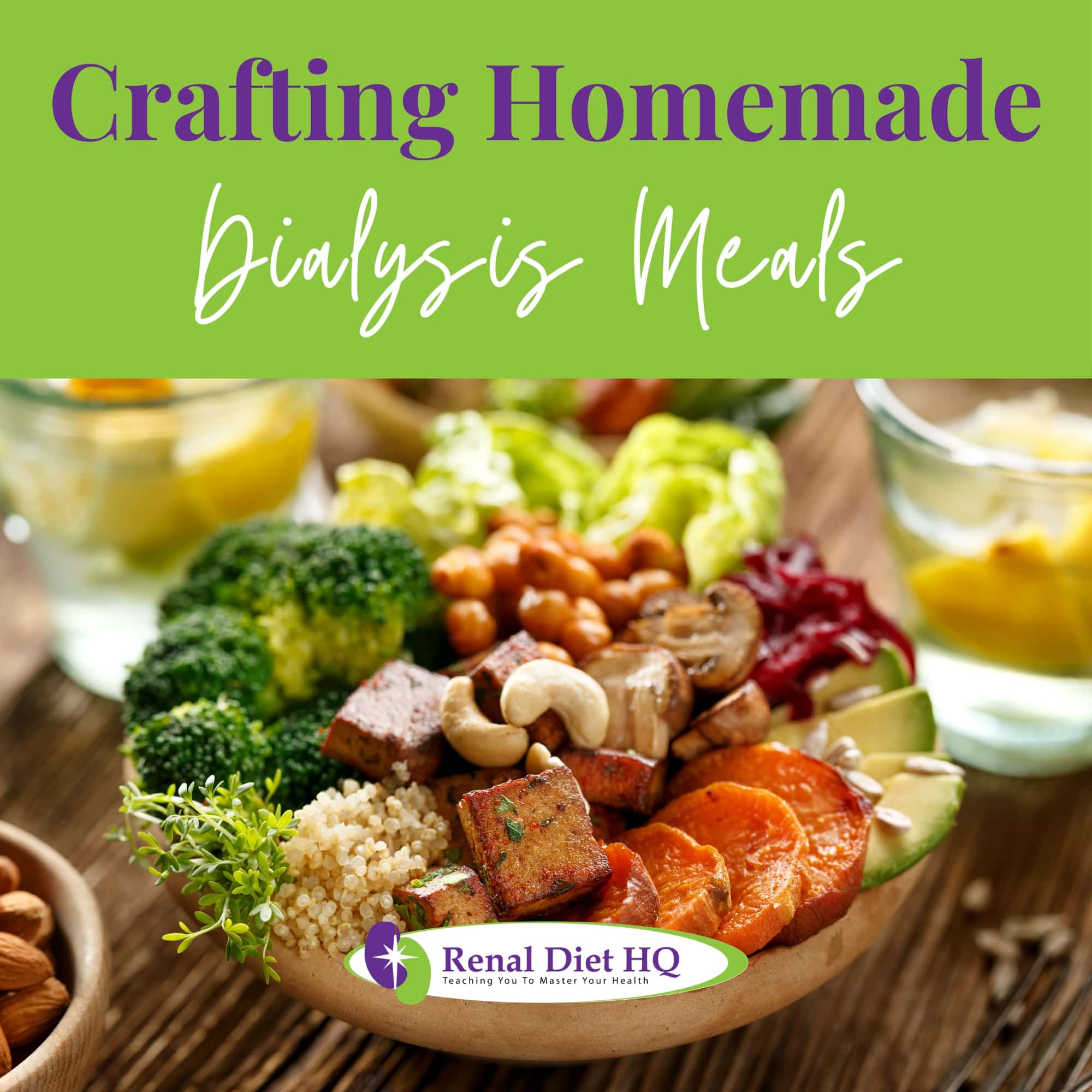
Recipe Adaptation Strategies
Adaptation is key as you transform favorite recipes into kidney-friendly meals for your balanced diet. By adapting recipes and modifying ingredients, you're not just tracking nutrients, you're enhancing well-being through each homemade meal.
Consider these recipe substitutions:
- Replace high potassium vegetables with low potassium options
- Swap potatoes for cauliflower
- Use apples instead of bananas
- Choose bell peppers over tomatoes
Cut down on phosphorus by selecting alternative grains:
- Opt for white rice over brown rice in your daily diet
- Use cornbread instead of whole wheat bread
- Enjoy rice-based cereals rather than bran
Monitor fluid intake with creative cooking methods:
- Steam veggies to reduce water content
- Thicken soups to limit liquid volume
- Serve smaller portions of beverages
Embrace these strategies to nourish and support your journey with love and care.
Ingredient Substitution Tips
Crafting homemade dialysis meals for your special diet starts with smart ingredient substitutions, ensuring you meet your dietary needs without sacrificing flavor or variety. Recipe adaptation and ingredient substitution are pivotal in managing your diet effectively.
Salt reduction techniques, such as using herbs instead of salt for seasoning, can significantly improve your heart health. Nutrient tracking is essential, be aware of the nutritional content in each substitution to maintain the balance your body requires.
Here's a table to guide your recipe modification:
| Original Ingredient | Substitute | Benefit |
|---|---|---|
| Salt | Herbs/Spices | Reduces sodium intake |
| Nuts | Egg whites | Lowers phosphorus |
| Dairy milk | Rice milk | Decreases potassium |
Adhering to Renal Diet Recommendations
You'll find success in managing your kidney health by incorporating recipe modification strategies into your meal preparation.
Keeping a precise track of your nutrient intake is essential, given your unique dietary needs while on dialysis.
Consult with your dietitian to tailor these recommendations, ensuring you're getting the right balance of nutrients without overburdening your kidneys.
Recipe Modification Strategies
Modifying your favorite recipes to fit renal diet recommendations is essential for maintaining your health while on dialysis without extra salt. Here's how you can adapt your meals with care and understanding:
Sodium Reduction
- Swap out table salt for fresh herbs and spices
- Read labels to avoid high-sodium processed foods
- Remember, your palate will adjust over time to less salt
Protein Sources
- Choose high-quality proteins like lean meats and eggs
- Practice portion control to manage intake
- Explore plant-based proteins, being mindful of potassium and phosphorus
Dairy Alternatives
- Opt for non-dairy milks like almond or rice milk
- Enjoy small amounts of low-phosphorus cheese varieties
- Indulge in dairy-free ice cream for a treat
Tracking Nutrient Intake
In line with the recipe modifications you've adopted, tracking your nutrient intake is crucial for sticking to your renal diet recommendations. Understanding sodium control is a significant aspect of managing your kidney health.
Be vigilant about hidden sodium sources in processed foods and use salt substitution strategies, like seasoning with herbs and spices, to enhance flavor without compromising your diet.
Prioritizing protein intake is essential, but it's equally important to choose sources low in potassium and phosphorus.
FAQs Dialysis Diet Menu Plan
When you're eating out or at social events, communicate with the restaurant about your dietary needs, specifically mentioning sodium content and fluid intake.
Research the menu ahead of time and practice portion control to keep within your restrictions.
It's essential for maintaining your health while still enjoying social occasions.
Your vigilance ensures you can serve yourself and others by staying healthy and active.
You can simplify meal prep with kitchen gadgets like a steamer basket or a pressure cooker, which preserve nutrients and reduce cooking time.
A nutritional scale ensures precise portion control, crucial for maintaining your health.
Silicone bakeware offers non-stick convenience without added fats and an herb infuser lets you flavor dishes richly, lessening the need for salt.
These tools assist you in creating wholesome meals that serve your body's needs efficiently.
As your kidney function changes and your stage of kidney disease is adjusted, you'll need to adjust your diet. Monitoring kidney function is crucial, and you may need to control fluid intake more strictly.
Phosphate binder usage can become necessary as you manage mineral balance. Adjusting potassium levels is also key.
After a transplant, you'll transition to a diet that supports your new kidney, often with less strict restrictions but still focused on maintaining optimal health.
When you're battling cravings for off-limits treats, try craving substitutions with healthy alternatives that mimic the textures or flavors you're missing.
Practice mindful eating; savor each bite to satisfy with less.
Portion control is key, indulge in a small, safe amount when appropriate.
Seek emotional support from friends, family, or support groups.
Don't underestimate hydration focus, sometimes a glass of water can curb the desire for snacks.
Dialysis Diet Menu Plan
You've got this! Controlling your sodium, prioritizing high-quality protein, and choosing kidney-friendly grains and dairy, means that you're on the right track. Embrace homemade meals that adhere to your renal diet, it's key to protecting your health on dialysis.
Remember, your choices have a powerful impact on your well-being. Stay informed, stay focused, and let your Dialysis Diet Menu Plan be the compass that guides you to better health.
You're not just eating, you're healing.

